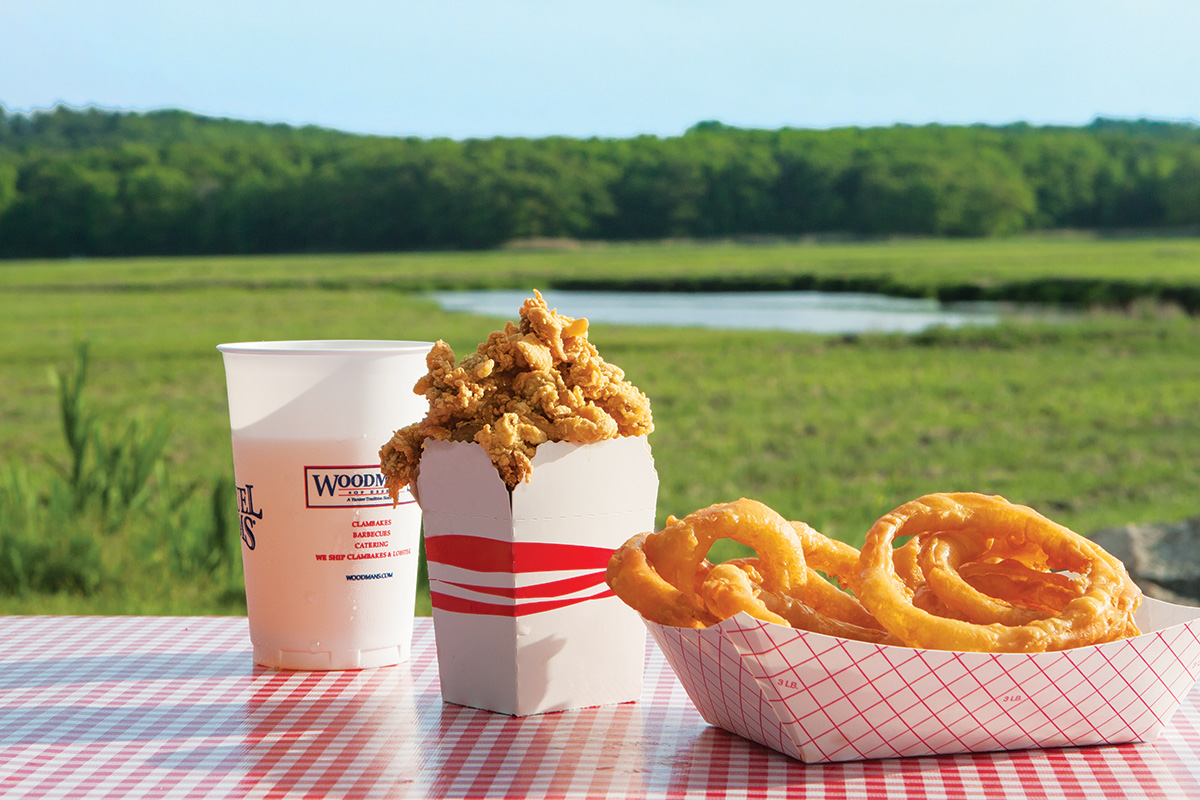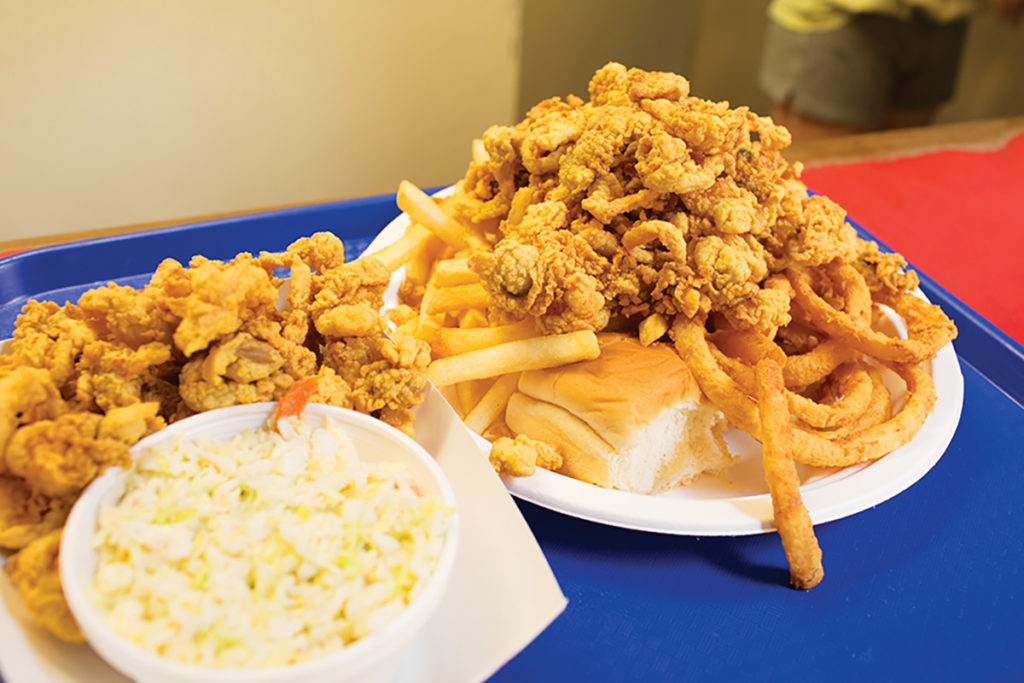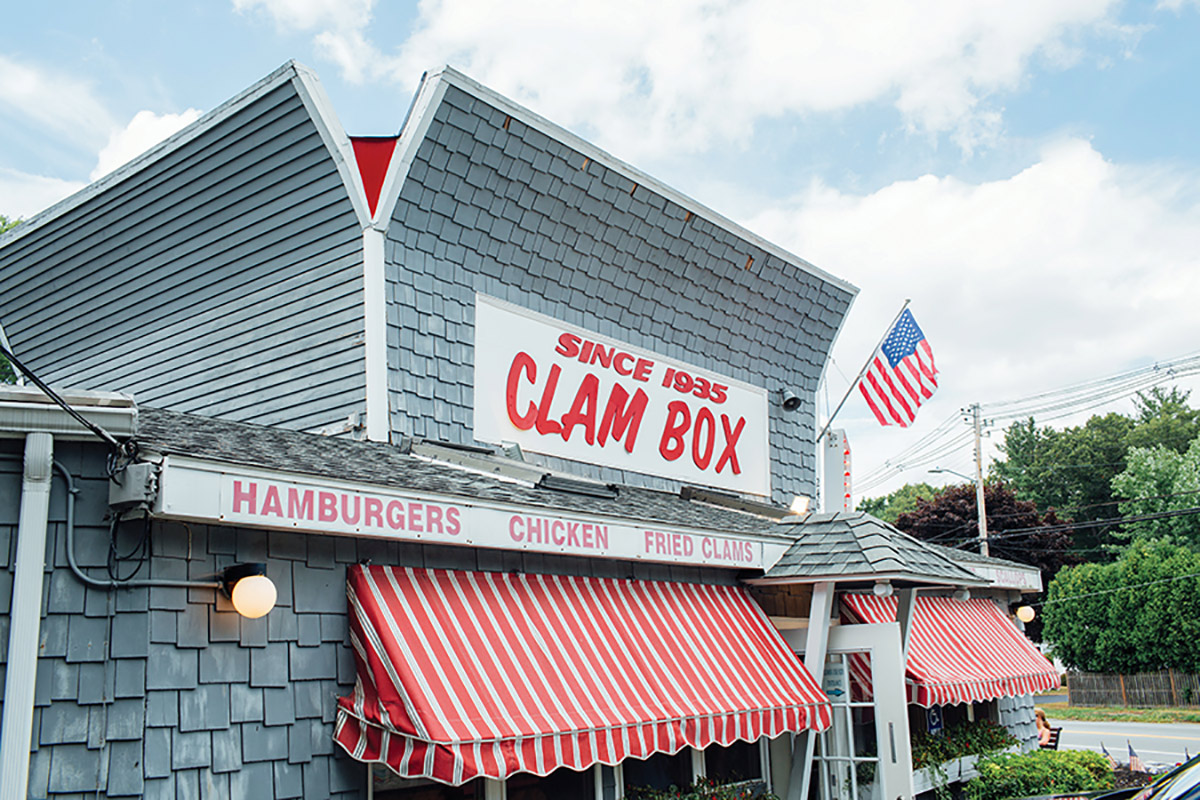If there is one thing the North Shore owns, it’s fried clams. Let others nitpick who made them first—did they appear in a recipe book in the 1800s? Were they on the menu at Boston’s Omni Parker House Hotel? Doesn’t matter to us.
What matters is that Lawrence “Chubby” Woodman came up with a recipe in 1916 that has remained the gold standard at Woodman’s of Essex for more than 100 years. And even in these difficult times, people will drive for hours, across multiple state lines, to get to our “Clam Highway”—otherwise known as Route 133—lined with flats and fryolators from Ipswich to Essex. Customers have been making the trek since before there were traffic lights.
“We’ve been through World War I, World War II, the Great Depression, the recession, the Vietnam War…,” says Maureen Woodman, who works as director of catering sales and whose husband, Doug Woodman, is a third-generation co-CEO. “But that’s the story of Woodman’s. We have survived.”
Woodman’s even survived the Spanish flu—and with that much history on the line, they’re not about to throw in the towel. Woodman says the third, fourth, and fifth generations of the family are working together at a brisk pace, showing up every day with fresh ideas, finding ways to meet the challenges that face restaurants now—right down to the number of informational signs papering the building.

by Robert Boyd.
“We have a lot of signs at Woodman’s,” Woodman says with a laugh. The wall hangings offer instruction on where to line up, how to order, and where to pick up food—all more necessary now than ever. “I would say we’ve tripled the signage in the past 48 days. We’ve spent more time, more money, more energy, and more meetings just trying to figure out what the signs should say, what the signs should look like, where the signs should go.” They’ve even painted lobster traps on the floor to indicate how far apart people should stand—the length of two traps is a good distance, it turns out, and much more on-brand than a taped-down “X.”
It’s all in service of ensuring that customers continue to have a happy—and safe—experience. Woodman’s has three acres of parking, which enables people who have traveled from afar to sit and eat the clams in their cars. Workers have blocked every other parking space with cones to ensure social distancing. And the company is in the process of going online for takeout orders. It should be fully operational by June, eliminating the desperate dialing that currently causes annoyance, and sometimes lost business.
While the experience is temporarily changing, the recipe remains the same. “The food is not a challenge,” Woodman says. “We’ve had the same exact recipe for 106 years.” For the uninitiated, Woodman’s luscious crisp clams have been gluten-free since the start—well before it was trendy. The recipe is just local bivalves, dipped in evaporated milk and gluten-free corn flour, fried in lard.
A few miles down 133, the Clam Box missed the Spanish flu, but not by much. The iconic cardboard container–shaped restaurant has stood the test of time for more than 80 years.

“They don’t make buildings like this anymore,” Johanna Aggelakis says with a laugh. That’s perhaps partly because snow collects inside the top of the iconic box-shaped stand each winter, and Johanna’s husband, Dmitri, has to climb in with a ladder to shovel it out.
Dmitri’s mother, Marina “Chickie” Aggelakis, has owned the restaurant since 1986, and she’s still managing quality control, albeit from her car and by phone while social distancing is required. Chickie is ensuring that enough cole slaw and tartar sauce is made fresh every morning, and that everything tastes just right. While she’s not in the kitchen, she’s frequently getting a plate brought out to her car to make sure nothing is going awry, Aggelakis says.
But with employees with decades of experience in the kitchen, Chickie probably needn’t worry. Like Woodman’s, Clam Box uses a recipe that has been handed down for generations—a proprietary blend of corn flour, which has come from the same family-owned business for 40 years, and pastry flour, fried in a mixture of beef fat and vegetable oil that is changed twice a day.
“Literally the clams that customers are eating today were dug this morning from the Ipswich flats,” Aggelakis says. “They go from the flats at 4 a.m. to the shucking house at 7 or 8 and then are delivered here at 9.”
Bob Lobster is the new kid on the block—they’ve only been slinging clams since 2001 or so, when Bob and Joyce Hartigan converted an ice cream stand into a seafood market that quickly morphed into a restaurant. When the Hartigans announced they were retiring in 2017, four friends from Plum Island, Brad DeLibero, Jasmine Lewan, Paul Rooney, and Kim-Soo DeLibero, bought the business.
Without the weight of history on their shoulders, DeLibero, who trained as a chef, changed up the recipe for the breading. The former owners dipped in white flour, then a powdered milk mixture then yellow flour. Now the clams are dipped in evaporated milk, then a mixture of white flour, corn flour, baking powder and a bit of salt.

“As soon as we made that swap, people [said] they could actually taste the seafood more,” DeLibero says. “Now it’s a lighter, crispier batter.”
While the fried clams haven’t experienced the same modern innovation as some of Bob Lobster’s lobster rolls (think wasabi cream, sriracha aioli, or butter-braised with avocado), you can order many of the lobster roll sauces as a dipping side. Or you can go all-out with the Fat Lobster: fried clams, cole slaw, and onion rings atop lobster salad on a toasted jumbo brioche.
It’s worth the trip—like the North Shore’s other clam shack treasures, people travel from many states for a taste. Recently, a police officers’ motorcycle club from all over New England roared into Bob Lobster for the perfect social distance lunch stop.
Fried seafood fans travel far and wide—North Shore residents are fortunate to access a perfect clam plate in under an hour. Chew on this as you support our local legends: “We have people coming from New York,” Maureen Woodman says. “They are leaving at eight in the morning, getting here at one o’clock, having clams and driving home. They said, ‘We have nothing else to do.’ Imagine. Nothing else to do but drive for 10 hours to get fried clams.” Yep, we’re a lucky bunch.
Get Your Fry On
Here are a few insider tips for avoiding the crowds at North Shore clam shacks. Please check social media for the latest from each spot. And don’t forget to tip generously if you can.
Bob Lobster
+ While the restaurant is still allowing walk-up orders, you can avoid lining up with people from all over by ordering over the phone and requesting curbside pick-up. Call when you arrive and staff will bring your meal out to you. You can call early in the day—or even the day before—to place an order to pick up later on.
49 Plum Island Turnpike, Newbury. 978-465-7100, boblobster.com
Clam Box
+ During social distancing, you must call ahead to order, but keep this number to yourself: 978-356-5019. That’s the secret insider hotline for orders. Call that number, tell them when you want to come by (you can call early in the day to place an order to pick up for dinner if you’d like), and pay by phone. They will call your name over the parking lot loudspeaker at the time you’ve requested. They are very prompt.
246 High St., Ipswich, 978-356-5019, clamboxipswich.com
Woodman’s of Essex
+ In the past months, Woodman’s has been doing call-ahead orders only. Currently, they’re only offering in-person and walk-up orders. Try going off-hours to get your order more quickly.
119 Main St., Essex, 978-768-6057, woodmans.com

